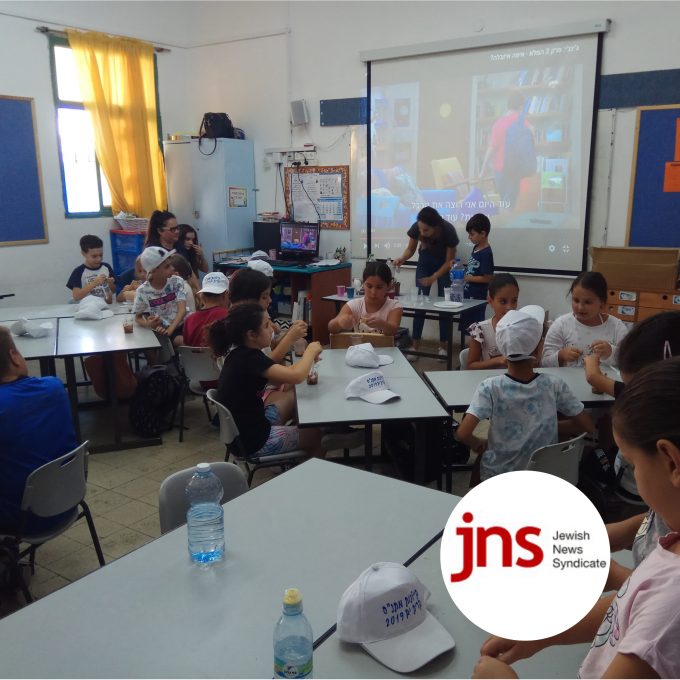Schools in Israel, Italy and the United Kingdom plan to take a trek to the stars in a joint project formulated by their teachers who were attending this year’s World ORT Hatter Technology Seminar in London. World ORT-affiliated Sha’ar HaNegev High School and the ORT school in Milan are looking forward to boldly going where they have not gone before in collaboration with Jews’ Free School (JFS) in London.
Together they will use powerful remote telescopes to take their teaching of astronomy and space-related science to a new level in a project facilitated by one of the presenters at the Hatter Seminar, Robert Hill, Director of the Northern Ireland Space Office.
“It’s an exciting example of the kind of cross-fertilisation which our international seminars foster,”? said the Head of World ORT’s Education Department, Daniel Tysman. “The study of space is a great way for children to encounter science. Astronomy not only opens children’s minds to imagine vast distances and to question the origin of the universe it can provide a springboard to mathematics, physics, and biological sciences as well as linking with geography, history and personal development.”?
All of which illustrates the theme of this year’s seminar: Integrated Approaches to STEM (Science, Technology, Engineering and Mathematics) Education. STEM knowledge is increasingly in demand and World ORT brought together 18 educators from Argentina, Brazil, Bulgaria, the Czech Republic, France, Lithuania, Russia, Ukraine, Israel and Mexico to explore how they could adapt their teaching to integrate subjects within and around STEM in a meaningful and relevant way.
“Many schools and colleges offer these subjects in a compartmentalised fashion out of necessity but this creates a risk that students can miss an opportunity to develop a broader understanding and to appreciate the “リinterconnectedness’ between different disciplines,”? Mr Tysman said. “Now that we’re moving towards a knowledge economy, an integrated approach makes more sense. Instead of teaching maths for one hour and history for one hour, this approach makes the material more relevant and more meaningful and so allows it to be absorbed more deeply.”?
Experts such as Dr David Barlex, Director of the Nuffield Design and Technology Project, stimulated and inspired the participants with presentations and workshops examining advantages and drawbacks to the integrated approach.
“I was very excited to be able to hear Dr Barlex and to meet him because his ideas were instrumental in the way we developed our approach to technology education,”? said ORT Argentina’s Marcos Berlatsky.
Dr Barlex not only started a private correspondence with Mr Berlatsky, he plans to use the experiences of several participants as case studies for a book he is writing on international approaches to STEM education.
Other experts included Lydia Showan, a maths specialist at the UK’s National STEM Centre, which offers a range of tools to support the teaching the subjects; Stephanie Sinclair, who shared insights from the Wellcome Trust’s evaluation of STEM provision in a number of London schools; Eleanor Byrne, Senior Research Fellow at Sheffield Hallam University and author of “Cross Curricular Teaching and Learning in the Secondary School”?, who explained how and why selected cross-curricular projects were successful; Professor Roger Malina of the University of Texas at Dallas and Nicola Triscott, of the UK’s Arts Catalyst, who explored the integration of contemporary art into science and technology education; and the University of London’s Dr Paul Curzon, who riveted everyone with his use of magic tricks to show how computer science can be taught in fun and creative ways.
The participants, too, presented their experiences and insights leading Mr Tysman to conclude that there is clearly “a lot of good practice going on already”?. But, he added, teachers were often acting within the constraints of their countries’ curricula which left little time for open-ended project learning.
“However, over the course of the Seminar we saw that a little bit of time spent coordinating between school departments can allow a lot to happen by actually saving time; for example, a maths department providing statistics for analysis in a science lesson,”? said Mr Tysman.
And over the course of the Seminar, participants learned from each other. As Sha’ar HaNegev Science and Technology teacher Ella Yonai said, “It was very interesting to know what is going on in different countries. All the participants were at a very high level and I have learned a lot about the way things are taught.”?
This was the beauty of World ORT’s international network, said World ORT President Dr Jean de Gunzburg.
“The network works if we’re all there to exchange,”? he said. “It’s nice to exchange using email and webinars but humans are only human and it’s good to get together once in a while, get to know each other personally and to exchange personally.”?
Dr de Gunzburg thanked his predecessor, Sir Maurice Hatter, for supporting the annual Seminar and it was Sir Maurice who encapsulated the importance of examining ways to make an ORT education a practical preparation for students’ adult life.
“We are preparing our students to enter a future that will place a high value on the development and exchange of knowledge and information,”? he said. “To thrive in such a dynamic and often uncertain environment, we must enable our students to gain expertise in a range of disciplines and to be comfortable moving among them.”?





